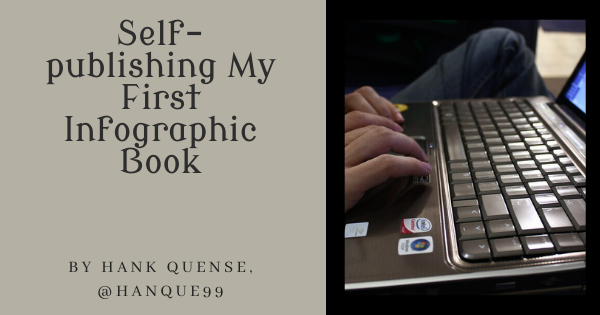I’ve written and published a number of books, both fiction and non-fiction, both print and ebook. All of these were text-based, sometimes with a few graphic files scattered about.
Recently, I bought a book on financial planning for the my grandkids. It was an infographic style book and as I thumbed through it, I had the idea that it would be cool to make an infographic edition of my book Creating Stories.
Once I began this project, I ran into a big problem, namely I knew squat about making infographics. After trying out a few websites, I settled on Canva and then spent time getting to understand how to use infographics and how to modify templates. After that, I started putting the new book together. Each page in the book is a single graphic file in .png format. The pages consist of text boxes, and small graphic elements added to a modified template and downloaded to my computer.
That led to a second problem: how to put together the book. I tried various word processors and discovered they were only suitable for text, not graphics. (I guess that is why they are called *word* processors). Once again I searched the internet and finally found a program called Swift Publisher 5. It’s used for desktop publishing and it cost $20 but it’s a Mac only program and it has a small learning curve. In a short time, I had figured out how to insert the Canva files into the publishing program on my computer.
Ultimately, I ended up with a book with 119 graphic files (or pages). The book took up over 70 megabytes of memory compared to around 12 or 13 megabytes for a text-based book.
Quite proud of myself, I soon discovered my process had created a huge problem. The book couldn’t be edited! My editor had to write down typos and other issues on a separate document instead of marking up the text. It created a headache for me also. I had to go to the Canva site and correct each page, download the new graphic file and replace the page in the Swift manuscript.
This was not fun and it was apparent I needed a new process before I stated on a new infographic book. Now, I write the text, break it up into text box chunks, establish page breaks, get that edited and use the corrected text to create the Canva files and the infographic pages.
Uploading the manuscript (or attempting to) led to a few surprises. Swift will only export to a pdf file and those types of files can’t be uploaded to Draft2Digital or Smashwords, thus limiting my ebook publishing options to Kindle which will allow a pdf upload. However, Kindle does whine a bit that a doc file is a better preference.
Once uploaded, both the print and ebook editions have pricing concerns that are quite different from text-only books. Because of the graphics, a print copy is about three times the cost of a text-only book. This severely limits the royalties that are available to the author. Jacking up the book price to increase royalties will decrease sales by making the book unattractive to many potential buyers.
Ebooks have a similar royalty limitation. This is caused by Kindle’s download fee for the 70% royalty option. Because of the large size of the download, the royalties are reduced by $2.07 per book. To compensate, the ebook price has to be much larger than most other similar ebooks. Indeed, if you search Amazon for infographic books, the price for most of them exceeds $10.
Now I understand why these ebooks are priced so high: authors have to eat you know.
Here is the Amazon page for the book; https://www.amazon.com/Infographic-Guide-Creating-Stories-ebook/dp/B09PKDSNFF/ref=sr_1_10?keywords=hank+quense&qid=1641570850&s=books&sr=1-10
I also ran into problems trying to promote such a large pdf file. The Booklife contest won’t accept any pdf files. The Booksprout review site won’t accept the file because it’s too large. I’m sure I’ll run into more problems as I continue to promote the book.
So, if you’re interested in seeing what an infographic ebook looks like, you can download a free sampler of my new book here: http://hankquense.org/wp-content/uploads/2022/01/Sampler-CS-info-V3-ebook.pdf


It was a voyage of discovery, wasn’t it, Hank? Thanks for sharing what you learned with us.
It was a learning process. However, I love learning new stuff. If I’m not learning or trying something new, I get bored.
Thanks for sharing your tips on how to publish an infographic book. It sounds complicated. Glad you figured it out.
It isn’t as bad it sounds. I made it more complicated than it really is because I didn’t think it through beforehand.
Thanks for sharing your experience with Infographic books. I can see their appeal, but it sounds like there’s quite a learning curve!
I does have a learning curve, but once you plow through the first one, the second one is quite easy. I can say this because I:m almost finished with a second one. It has to do with mind-mapping a novel.